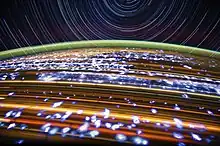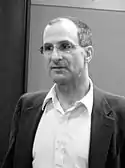Donald Pettit | |
|---|---|
 Pettit in 2002 | |
| Born | Donald Roy Pettit April 20, 1955 |
| Status | Active |
| Nationality | American |
| Occupation | Chemical engineer |
| Space career | |
| NASA Astronaut | |
Time in space | 369 days 16 hours 41 minutes |
| Selection | 1996 NASA Group |
Total EVAs | 2 |
Total EVA time | 13 hours 17 minutes |
| Missions | STS-113, Expedition 6, Soyuz TMA-1, STS-126, Soyuz TMA-03M (Expedition 30/31) |
Mission insignia | |
| Education | Oregon State University (BA) University of Arizona (PhD) |
| Scientific career | |
| Fields | Chemical engineering |
| Thesis | Coherent detection of scattered light by submicrometer aerosols (1983) |
| Doctoral advisor | Thomas W. Peterson |
Donald Roy Pettit (born April 20, 1955) is an American astronaut and chemical engineer best known for his orbital astrophotography and in-space inventions such as the microgravity coffee cup, which received the first ever patent for an object invented in space. [1] He is a veteran of two long-duration stays aboard the International Space Station, one Space Shuttle mission and a six-week expedition to find meteorites in Antarctica. As of 2023, at age 68, he is NASA's oldest active astronaut.
Early life and education
Pettit was raised in Silverton, Oregon, and is an Eagle Scout.[2] He is married to Micki Pettit and has twin sons.[3]
Pettit earned a Bachelor of Science degree in chemical engineering from Oregon State University in 1978, followed by a Ph.D. from the University of Arizona in 1983.
NASA career
Pettit worked as a scientist at the Los Alamos National Laboratory until 1996 when he was selected as an astronaut candidate by NASA. He was a junior advisor to the Synthesis Committee of the Space Exploration Initiative on its May 1991 report "America at the Threshold", recommending plans for a human mission to Mars.[4]: A-7

An astrophotographer, Pettit captured thousands of unique star trails and photographic data sets, which he regularly shares online. One, titled 'Lightning Bugs', went viral on the internet.[5]
Spaceflight experience
Expedition 6

Pettit's first space mission was as a mission specialist on ISS Expedition 6 in 2002 and 2003. During his six-month stay aboard the space station, he performed two EVAs to help install external scientific equipment. During free time on his stay aboard the International Space Station, he conducted demonstrations showing how fluids react in an extremely low gravity environment in a series he called "Saturday Morning Science".[6]
The Expedition 6 mission was extended by about two months, following the loss of the Space Shuttle Columbia in February 2003 and the subsequent grounding of the shuttle fleet. Instead of returning on a shuttle, the crew returned in a Russian Soyuz capsule, the first time American astronauts had launched on the Space Shuttle and landed in a Soyuz.[7]
STS-126
Pettit was mission specialist 1 on the STS-126 mission to deliver equipment and supplies to the ISS.[8]
Pettit also performed experiments on board ISS related to the clumping of solid particles in microgravity. The experiments showed that particles of various materials which varied in size between 1 micrometer and 6 mm naturally clumped together in microgravity when confined to a volume of 4 liters that included a few grams of the materials. The cause was theorized to be electrostatic. This presents a plausible mechanism for the initial stages of planetary formation, since particles of this size do not have sufficient gravity to cause this phenomenon.[9][10]
Expedition 30/31
Pettit again launched to the International Space Station on December 21, 2011, as part of the Expedition 30/31 crew.[11] He and fellow crew members Oleg Kononenko and André Kuipers arrived at the ISS on December 23.[12] Among his off-duty video demonstrations on the space station has been on water as thin film and the Marangoni convection.[13] On May 25, 2012, Pettit and Kuipers operated the Canadarm2 to grapple the first SpaceX Dragon 1 and berth it to the Harmony module.[14] This marked the first time a private spacecraft had ever rendezvoused with the ISS. The Dragon capsule was carrying supplies for the ISS, and the successful capture demonstrated the feasibility of using privately developed spacecraft to resupply the station. Pettit was the first to enter the uncrewed supply ship on May 26, making him the first astronaut in the history of space exploration to successfully enter a commercially-built and operated spacecraft in orbit. During the capture, he was quoted saying, "Houston, Station, we've got us a dragon by the tail."
Angry Birds Space Demos

During Expedition 30, on behalf of NASA in cooperation with Finland-based Rovio Entertainment, creator of the Angry Birds franchise, Pettit also made another video by using an Angry Birds character to explain how physics works in space, including demonstrating trajectories in microgravity by catapulting a Red Bird through the space station.
NASA states that such collaboration may share the excitement of space with the game community, educate users on NASA's programs, and create interactive educational experiences for the public.[15]
The footage was released by NASA both on its official site and YouTube along with another commercial version by Rovio on March 8, 2012, to announce the launch of new game Angry Birds Space on March 22, 2012.[16]
Expedition 71/72
In September 2024, Pettit will fly on Soyuz MS-26 with Aleksey Ovchinin and Ivan Vagner. His return is planned for March 2025.
Innovations and inventions
During Expedition 6, Pettit used spare parts found throughout the Station to construct a barn door tracker; the device compensates for the movement of the ISS relative to the Earth's surface, permitting sharper high resolution images of city lights at night from the orbiting space station.[17][18]
In November 2008, Pettit invented the zero-g coffee cup, which used the wetting angle to carry fluid along a crease to permit drinking and avoid the necessity of a straw. This zero-g cup was featured in the May 2009 National Geographic Magazine issue, along with his notes on the relation of the internal cup angle to the contact wetting angle for various construction materials.[19][20] The cup received the first ever patent for an object invented in space. [21]
Antarctica

From November 2006 through January 2007, Pettit joined the Antarctic Search for Meteorites (ANSMET), spending six weeks in the Antarctic summer collecting meteorite samples,[22] including a lunar meteorite. During the expedition, he was called on to perform emergency electrical repairs to a snowmobile and emergency dental surgery. Periods of tent-confining inclement weather were spent continuing his Saturday Morning Science series—"on Ice"—with photographic surveys of crystal sizes of glacial ice samples and collections of magnetic micrometeorites from ice melt used for cooking water. (He estimated Antarctic glacial ice to contain roughly 1 micrometeorite per liter.)
References
- ↑ https://www.youtube.com/watch?v=Xbxw4V69IzU
- ↑ "Astronauts and the BSA". Fact sheet. Boy Scouts of America. Retrieved 2010-09-16.
- ↑ "Ballistic Entry". NPR.org.
- ↑ "America at the Threshold" (PDF). USRA. May 3, 1991. Retrieved December 21, 2022.
- ↑ "Star Trails in Space Captured by NASA Astronaut in Incredible Viral Image". Newsweek. 21 September 2022.
- ↑ NASA.gov
- ↑ Jones, Chris (6 March 2007). Too Far from Home: A Story of Life and Death in Space (1st ed.). Doubleday. ISBN 978-0385514651.
- ↑ Schwartz, John (2008-11-14). "Handyman to Return to His Space Workshop". The New York Times. Retrieved 2009-08-31.
- ↑ "FAST, REPEATABLE CLUMPING OF SOLID PARTICLES IN MICROGRAVITY" (PDF). S. G. Love and D. R. Pettit. Retrieved 2010-05-29.
- ↑ "Building Planets in Plastic Bags". Sky and Telescope. Retrieved 2010-05-29.
- ↑ "New expedition 30 crew members launch to station". NASA. 2011-12-21.
- ↑ Klotz, Irene (23 December 2011). "New crew arrives at International Space Station". Reuters. Archived from the original on 9 January 2012. Retrieved 23 December 2011.
- ↑ Don Pettit (2012-03-08). "Thin Film Physics". PhysicsCentralAPS.
- ↑ Jonathan Amos (2012-05-25). "Station grabs SpaceX Dragon ship". BBC News. Retrieved 2012-05-25.
- ↑ "What Is Microgravity?". 2012-03-08. Retrieved 2012-03-22.
- ↑ "Angry Birds in Space". 2012-03-08. Retrieved 2012-03-22.
- ↑ Cindy Evans & Will Stefanov (22 April 2008). "Cities at Night: The View from Space". NASA. Retrieved 2009-08-31.
- ↑ "Space Station Astrophotography". NASA. Archived from the original on 2009-08-14. Retrieved 2009-08-31.
- ↑ Charlie White. "Astronaut invents coffee cup for a weightless cup o' joe". Archived from the original on 2011-07-23. Retrieved 2009-08-31.
- ↑ "The Zero Gravity Coffee Cup | Science Mission Directorate".
- ↑ https://www.youtube.com/watch?v=Xbxw4V69IzU
- ↑ "Don Pettit Goes to Antarctica". 2006-12-11. Archived from the original on 2007-10-31. Retrieved 2007-09-21.
![]() This article incorporates public domain material from websites or documents of the National Aeronautics and Space Administration.
This article incorporates public domain material from websites or documents of the National Aeronautics and Space Administration.